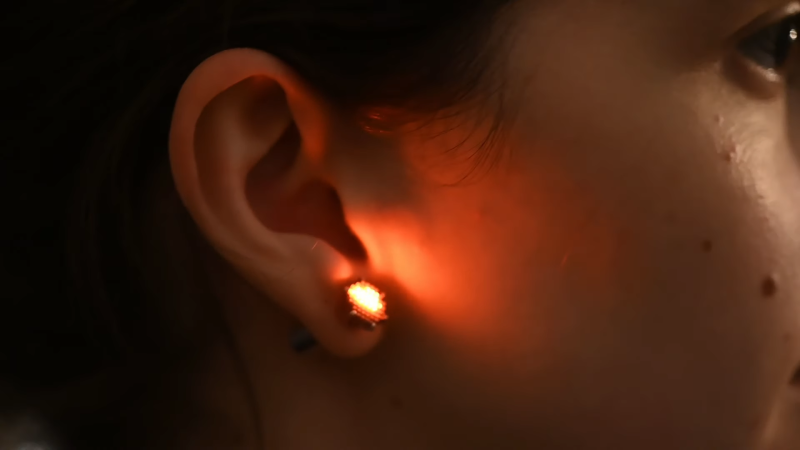We’ll be honest with you: we’re not sure if the use of “LED stud” in [mitxela]’s new project refers to the incomprehensibly tiny LED matrix earrings he made, or to himself for attempting the build. We’re leaning toward the latter, but both seem equally likely.
This build is sort of a mash-up of two recent [mitxela] projects — his LED industrial piercing, which contributes the concept of light-up jewelry in general as well as the power supply and enclosure, and his tiny volumetric persistence-of-vision display, which inspired the (greatly downsized) LED matrix. The matrix is the star of the show, coming in at only 9 mm in diameter and adorned with 0201 LEDs, 52 in total on a 1 mm pitch. Rather than incur the budget-busting expense of a high-density PCB with many layers and lots of blind vias, [mitexla] came up with a clever workaround: two separate boards, one for the LEDs and one for everything else. The boards were soldered together first and then populated with the LEDs (via a pick-and-place machine, mercifully) and the CH32V003 microcontroller before being wired to the power source and set in the stud.
Even though most of us will probably never attempt a build on this scale, there are still quite a few clever hacks on display here. Our favorite is the micro-soldering iron [mitxela] whipped up to repair one LED that went missing from the array. He simply wrapped a length of 21-gauge solid copper wire around his iron’s tip and shaped a tiny chisel point into it with a file. We’ll be keeping that one in mind for the future.
Thanks to [spacedog], [hackbyte], and everyone else who spied this one for us.

















What’s the power supply? Could they have used body voltage to power these LEDs?
I suspect there’s a small button cell in the chunky-looking back piece.
I would buy them as cufflinks.
Very very impressive!
The thing surprised me most is how damn cheap a decent pick n place machine has become. this PnP is ~$4k on amazon, not in the hobbyist price range, but certainly a goer for a successful tindie etc.
Interesting project I wonder could a pair of e-ink earrings be made, where you set the image and change the image whenever you desire. You set the image and need no power until the next image is displayed. And power is only needed when the image is changed which could be when it is interfaced to a computer. Anyone know how small e-ink displays can get (at a not unreasonable price for one display) ?
Love it!. It would be awesome if we could use one of those rounded displays we see on smart watches. Or maybe find a Chinese manufacturer of custom displays/leds. I would put some text like: If you can read this you are too close to me!
That’s really really impressive!
Did a bad led go unnoticed at around 18:18 though?
Looks like it but I’ll cut him some slack, 0201 cant be easy to work with (the smallest I’ve gone is 0402 and those were a right pain).
He actually fixed that led in a follow-up video
I imagine my wife wearing those. Cool as ice.
Nice fingerprint.
Next project is to unlock his bank account…